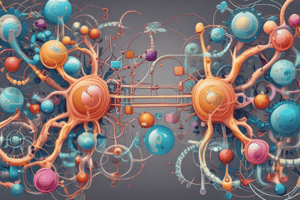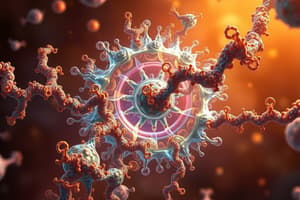Podcast
Questions and Answers
What is a primary characteristic of enzymes regarding their structure during chemical reactions?
What is a primary characteristic of enzymes regarding their structure during chemical reactions?
- Enzymes are completely degraded during the reaction.
- Enzymes are only active in extreme conditions.
- Enzymes can be altered to fit any substrate.
- Enzymes remain unchanged during the reaction. (correct)
Which model explains that the active site of an enzyme adjusts its shape to accommodate the substrate?
Which model explains that the active site of an enzyme adjusts its shape to accommodate the substrate?
- Substrate inhibition model
- Lock & key model
- Induced fit model (correct)
- Fixed theory
What defines the specificity of enzymes?
What defines the specificity of enzymes?
- Each enzyme interacts with one or few types of substrates. (correct)
- Enzymes interact with a wide range of substrates.
- Enzymes can catalyze multiple reactions equally well.
- Enzymes are ineffective if substrates are similar.
What is the term for enzymes that require additional non-protein molecules for their activity?
What is the term for enzymes that require additional non-protein molecules for their activity?
How many substrate molecules can a single enzyme molecule transform into product each second?
How many substrate molecules can a single enzyme molecule transform into product each second?
What is the primary effect of increasing enzyme concentration while substrate concentration remains constant?
What is the primary effect of increasing enzyme concentration while substrate concentration remains constant?
Which type of inhibitor decreases enzyme activity by binding to the active site?
Which type of inhibitor decreases enzyme activity by binding to the active site?
What effect does a noncompetitive inhibitor have on the Km of an enzyme?
What effect does a noncompetitive inhibitor have on the Km of an enzyme?
How do allosteric effectors influence enzyme activity?
How do allosteric effectors influence enzyme activity?
What is a characteristic of irreversible inhibitors?
What is a characteristic of irreversible inhibitors?
What is the main role of cofactors in holoenzymes?
What is the main role of cofactors in holoenzymes?
Which statement accurately describes the Michaelis Constant (Km)?
Which statement accurately describes the Michaelis Constant (Km)?
What distinguishes coenzymes from cofactors?
What distinguishes coenzymes from cofactors?
How does compartmentalization affect enzyme activity in cells?
How does compartmentalization affect enzyme activity in cells?
What effect does a small Km value have on enzymatic activity?
What effect does a small Km value have on enzymatic activity?
Flashcards are hidden until you start studying
Study Notes
Enzyme Definition and Mechanism of Action
- Enzymes are primarily protein catalysts that accelerate reaction rates.
- They are synthesized intracellularly but can function extracellularly.
- Enzymes remain unchanged during reactions and direct all cellular metabolic reactions.
- The lock-and-key model proposes a rigid active site with substrate specificity.
- The induced-fit model describes a flexible active site that adapts to the substrate, broadening substrate specificity.
Enzyme Properties
- All enzymes are proteins, except ribozymes (RNA).
- Enzymes possess an active site where substrates bind, forming an enzyme-substrate (ES) complex that converts to an enzyme-product (EP) complex before product release.
- Enzymes exhibit high catalytic efficiency, converting numerous substrate molecules per second.
- Enzymes display high substrate specificity, interacting with limited substrate types and catalyzing specific reactions (e.g., urease for urea, amylase for glycogen/starch).
- Holoenzymes consist of an apoenzyme (protein part) and a cofactor (metal ion or coenzyme). Apoenzymes are inactive without the cofactor. Coenzymes, sometimes derived from vitamins (e.g., NAD+ from niacin), can associate transiently or permanently.
- Enzyme activity is regulated through activation or inhibition.
- Enzymes are compartmentalized within cells for reaction isolation.
Factors Affecting Enzyme Activity
- Each enzyme has an optimal pH.
- Blood pH level influences enzyme activity.
- Substrate concentration affects reaction rate.
- Km (Michaelis constant) represents the substrate concentration at half-maximal velocity (Vmax). A low Km indicates high substrate affinity, while a high Km suggests low affinity.
- Enzyme concentration directly impacts reaction rate (at constant substrate concentration).
Enzyme Inhibition
- Inhibitors reduce reaction velocity.
- Reversible inhibitors bind non-covalently, while irreversible inhibitors bind covalently.
- Competitive inhibitors bind to the active site, competing with the substrate, increasing Km, but their effect is reversible with increased substrate.
- Noncompetitive inhibitors bind to allosteric sites, altering enzyme shape and preventing substrate binding. Their effect is irreversible, and Km remains unchanged.
Enzyme Activity Regulation
- General regulation involves increased activity with higher substrate concentration.
- Special mechanisms include allosteric effectors (positive or negative), covalent modification (phosphorylation or zymogen activation), altered synthesis rates (induction/repression), and feedback product inhibition.
- Allosteric effectors bind at non-active sites, modifying enzyme shape and activity.
- Covalent modification involves adding or removing groups (e.g., phosphorylation) to alter activity. Zymogens are inactive enzyme precursors activated by modification (e.g., trypsinogen to trypsin).
- Adjusting enzyme synthesis rates (induction/repression) controls enzyme abundance, a slower process.
- Feedback inhibition involves product inhibition of earlier enzymes in the metabolic pathway.
Medical Importance of Blood Enzymes
- Blood enzymes are either functional in blood (e.g., coagulation factors) or released from cells during normal turnover.
- Elevated levels of non-functional blood enzymes indicate tissue damage.
- Enzyme levels diagnose diseases affecting heart, liver, muscles, etc.
- Specific enzymes may indicate damage to a particular organ (e.g., alanine aminotransferase (ALT) elevation suggests liver disease). Enzyme level elevation correlates with the extent of tissue damage.
Studying That Suits You
Use AI to generate personalized quizzes and flashcards to suit your learning preferences.



